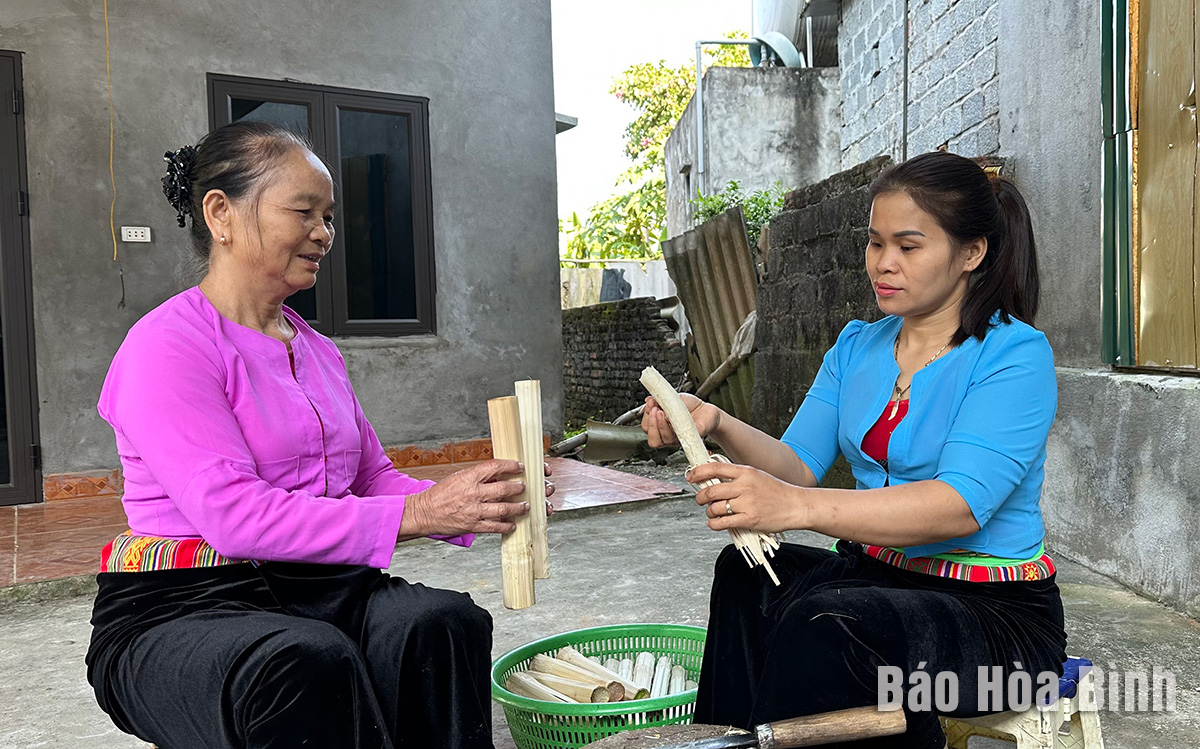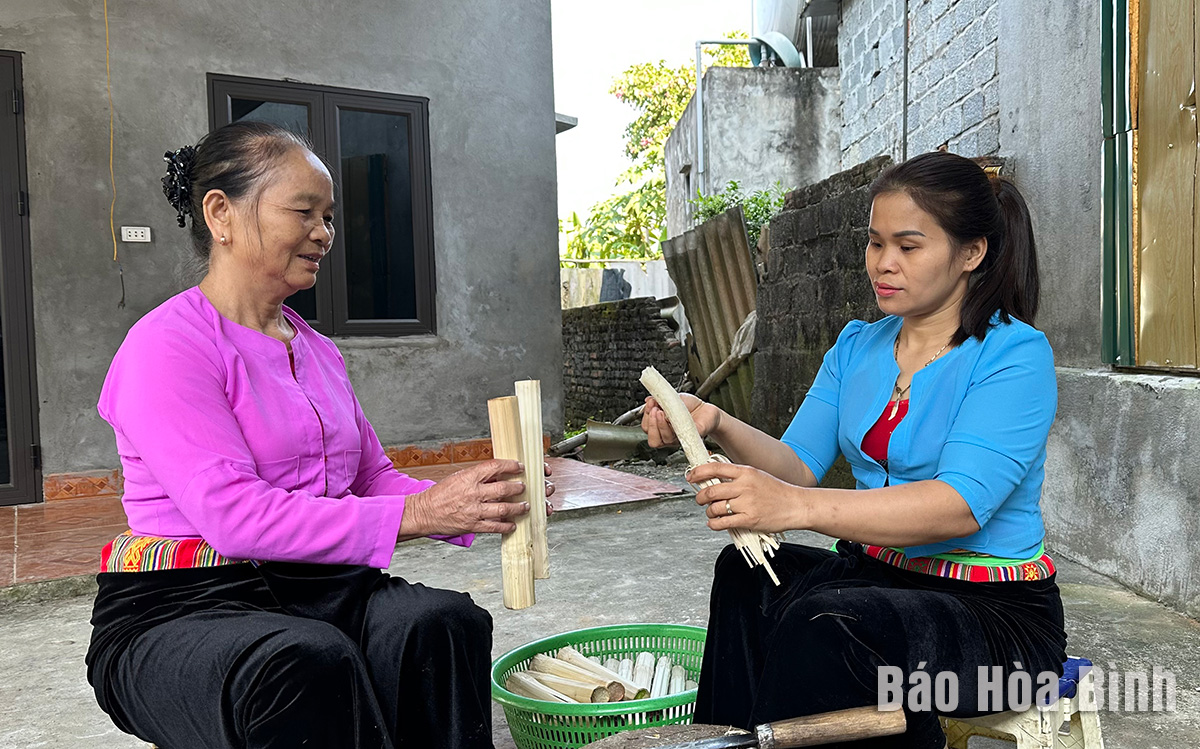
Beyond being a local staple rated as a three-star OCOP product, com lam (steamed sticky rice in bamboo pipes) has been imbued with the culture of the Muong Dong ethnics who believe that com lam is an accomplishment of the locals after a hard working year, and an indispensable delicacy to tickle Tet holiday taste buds.
Photo: Locals in Mo Da residential area, Bo town, Kim Boi district, develop Muong Dong com lam into a three-star OCOP product.
The quintessence of Muong Dong
In order to create the distinctive flavour of com lam, Muong Dong people meticulously select ingredients, with large and milky white glutinous grains preferred. The rice is soaked for about 8-12 hours before being rinsed thoroughly and mixed with a pinch of salt and finely chopped coconut flesh. It is then tightly packed into bamboo tubes and filled with water up to the brim.
As for bamboo tubes, they should be 35-40 centimetres long, cut from fresh and sturdy bamboo trees which are not too old or too young to avoid the rice from drying out or getting burnt.
The rice tubes must be roasted over charcoal between 45 and 50 minutes, and rotated every 15 minutes until they are fragrant.
Com lam could be served with grilled pork, chicken, minced fired pork and pickled bamboo shoots; however, it offered the best taste when paring with muoi vung (minced roasted peanuts, sesame and salt).
According to Dinh Thi Ly, a resident in Mo Da who has considerable experience in making com lam, the secret to making tender and fragrant com lam lies in the glutinous rice grown in mineral-rich water land, and the cook’s experience.
In the Muong customs, men are responsible for preparing meals. However, when it comes to com lam, all people are adept at making it. Com lam has been an integral part of the locals’ daily life and become a unique feature of the Muong culture.
Making com lam reach far and wide
There are currently over 30 households in Mo Da residential area making com lam. To meet market demands, they have worked to improve the production process while still preserving its traditional essence. Along with enhancing product quality, they have focused on improving the product’s packaging and labelling them with origin-tracing stamps. Besides, all products are vacuum-sealed for better preservation. Currently, Muong Dong com lam is served at restaurants and put on sale at supermarkets in many provinces and major cities nationwide.
Pham Hong Son, an owner of Muong Dong com lam production establishment, said his family sells up to 8,000 com lam tubes each month to the market, each valued at 7,000-8,000 VND (0.29-0.33 USD).
As part of the efforts to develop the brand of Muong Dong com lam, locals want to set up a cooperative to gradually complete procedures to develop geographical indication, further improve product quality, and expand market for the staples, he added.
Com Lam not only enriches the culinary culture of the Muong Dong people but also contributes to promoting the Muong culture to tourists and those interested in exploring the traditional cuisine. The lives of the people in Muong Dong have undergone many changes, but com lam remains an indispensable traditional dish, and a gift that is spotlighted at festivals, fairs, and events.
The Government Office with Document No. 2082/VPCP-KGVX, dated March 29, 2024, sent out the opinion of Deputy Prime Minister Tran Hong Ha regarding the submission of the "Mo Muong" and "Cheo art" dossiers to the United Nations Educational, Scientific and Cultural Organization (UNESCO).
In the evening of March 28th, in Hoa Binh, the Department of Grassroots Culture (Ministry of Culture, Sports and Tourism) coordinated with the provincial Departments of Culture, Sports and Tourism and the city to organize a mobile propaganda contest to celebrate the 70th anniversary of Dien Bien Phu Victory (May 7th, 1954 - May 7th, 2024) with the theme "Returning to Dien Bien”. There ứa the attendance of Mr. Nguyen Van Toan, the Vice Chairman of the Provincial People's Committee; the representatives of the leaders from a number of departments, branches and numerous veterans and Hoa Binh people.
In responding to the movement of "All people stay united to build cultural lifestyle”, over the years, Kim Boi district has conducted many practical and effective activities to promote solidarity and mutual support among the local community in sustainable poverty reduction and building cultural lifestyle and a healthy cultural environment, and maintaining national cultural identity.
Hoa Binh Pedagogical College has just held the closing ceremony of the training class and issued the certificate of the language of Muong ethnic people to the oficials, civil servants and public employees of courses I and II in 2023.
Hoa Binh is an ancient land home to limestone mountains running along the southeast direction and in parallel with Truong Son Mountain Range in the West, forming many basins and valleys with a rich diversity of fauna and flora. Humans came to reside here in the pre-historic period, creating the world-famous Hoa Binh Civilisation.



